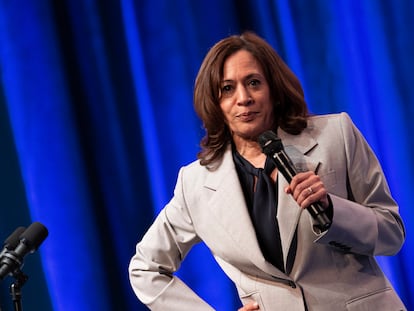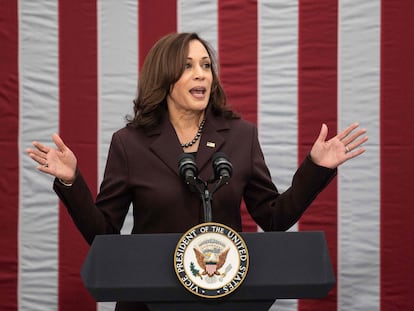In Southeast Asia, Kamala Harris is at the center of White House efforts to counterbalance China
The vice president’s approval ratings remain underwater, and her announcements in Southeast Asia tend to be counted in the millions of dollars rather than the billions. But she described her work in the region as something that will pay dividends over time

It took more than a day of flying, including two refueling stops, for Vice President Kamala Harris to reach this year’s summit of Southeast Asian countries. And once she arrived, she had less than eight minutes of public speaking time during two meetings.
But in Jakarta’s cavernous convention center, adorned with billowing flowers and tropical plants for the occasion, Harris saw an opportunity to shape the future of United States foreign policy.
In an interview with The Associated Press, the vice president said that Washington must “pay attention to 10, 20, 30 years down the line, and what we are developing now that will be to the benefit of our country then.”
For her, that means working in Southeast Asia. Two-thirds of its population is under 35 years old. It’s the fourth-largest market for U.S. exports. One-third of global shipping travels through the South China Sea.
“Think about it,” Harris said.
This was her third trip to Southeast Asia since taking office — Harris heads back to Washington on Thursday — and she’s visited more countries here than any other region. It’s a sprawling constellation of nations, many of them eager for the personal touch of an American leader, and Harris has spent the past few years making the rounds.
Although addressing migration from Central America was the original task in Harris’ foreign policy portfolio, her more recent travels have put her at the center of White House efforts to bolster ties in Asia as a counterbalance to China. It’s an international parallel to her more prominent role in domestic politics, where she’s been taking the lead on core Democratic issues such as abortion rights in the upcoming election.
At home and abroad, progress can be slow or hard to measure. Harris’ approval ratings remain underwater, and her announcements in Southeast Asia tend to be counted in the millions of dollars rather than the billions. But she described her work in the region as something that will pay dividends over time as she gets to know its leaders.
“The strongest relationships will be based on consistency, on communication, on trust, and the ability to work together and to grow the sense of connection,” she said.
Jake Sullivan, President Joe Biden’s national security adviser, said “many of our best successes in the region were made possible thanks to her diplomacy,” crediting Harris with helping to “move the ball forward on some of our top priorities.”
“In our administration, she has been a strong advocate for stepping up our engagement in Southeast Asia — and she’s put in the air miles to prove that — in recognition that our work there is critical to our own security and economic growth,” Sullivan said.
Some analysts believe China maintains an edge in the region, and the Australia-based Lowy Institute issued a report earlier this year concluding that Beijing was still gaining ground in recent years.
However, Harris delivered a series of messages at the Association of Southeast Asian Nations that were intended to demonstrate American commitment despite Biden’s absence from the summit.
“The American people have a profound stake in the future of the Indo-Pacific,” she said during one meeting. “We share a historic bond and common values with many of the people and nations here.”
Harris also paid tribute to ASEAN as an organization, despite growing doubts about its effectiveness for regional diplomacy.
“The fact that so many leaders are convening in this one place at the same time to address some of the biggest challenges facing our world is a sign of strength of both the commitment that each nation has to the coalition and the potential for collaboration,” she told the AP.
Others are less hopeful.
Dinna Prapto Raharja, a Jakarta-based analyst and professor on international relations, said ASEAN is being divided by competition between the U.S. and China, with some countries seeking to bolster their economies through closer relations with one or the other.
“I don’t see solidarity at this moment, given the rivalry,” she said. “Everybody works their own way.”
Harris’ travel to Southeast Asia began in her first year in office, when she visited Singapore and Vietnam, but the trip almost didn’t happen.
Phil Gordon, a national security adviser to Harris, said there was talk of canceling because the administration was in the midst of a chaotic withdrawal from Afghanistan.
“She personally insisted that we can do more than one thing at a time,” Gordon said. “She didn’t want to pull the plug on our commitment to Southeast Asia.”
During the trip, she repeatedly criticized China for trying to control access to the South China Sea, at one point describing the behavior as “bullying.”
“She didn’t knock it out of the park. It’s clear she was new to the issues. But she’s put in the work,” said Gregory B. Poling, who directs the Southeast Asia program at the Center for Strategic and International Studies.
He described Harris as “an effective avatar for the administration,” an important position when the president can only be in so many places at once.
David Rothkopf, a foreign policy writer who worked on trade issues under former President Bill Clinton and has met with Harris, said there’s “always a period of adjustment” for an incoming administration.
“She was new to the team,” he said. “And now she’s seen as part of the team.”
It’s a role that she’s played frequently. In addition to skipping this year’s ASEAN summit, Biden didn’t attend the 2022 Asia-Pacific Economic Cooperation conference in Thailand because it conflicted with his granddaughter’s wedding.
Harris went in his place, and she also stopped in the Philippines, a U.S. treaty ally where she’s fostered a close relationship with Philippine President Ferdinand Marcos Jr.
During the visit, Harris became the highest-ranking U.S. official to go to Palawan, an island adjacent to the South China Sea. She toured a Philippine coast guard boat and spoke with members of a local fishing community.
Republicans tried to turn it into an unflattering viral moment, clipping a video to portray her as awkwardly as possible as she greeted people with buckets of fish on their head.
But to her office, it’s an example of how Harris is willing to show up places where others don’t. She frequently participates in events outside the hermetic bubble of international summits or government events.
In Vietnam, she met with activists working on gay rights and climate change. In Thailand, she sat down with environmental advocates and clean energy entrepreneurs.
“We have to see the future and think about where it’s going,” Harris told the AP, “and then measure ourselves against that in terms of what we do today.”
Sign up for our weekly newsletter to get more English-language news coverage from EL PAÍS USA Edition
Tu suscripción se está usando en otro dispositivo
¿Quieres añadir otro usuario a tu suscripción?
Si continúas leyendo en este dispositivo, no se podrá leer en el otro.
FlechaTu suscripción se está usando en otro dispositivo y solo puedes acceder a EL PAÍS desde un dispositivo a la vez.
Si quieres compartir tu cuenta, cambia tu suscripción a la modalidad Premium, así podrás añadir otro usuario. Cada uno accederá con su propia cuenta de email, lo que os permitirá personalizar vuestra experiencia en EL PAÍS.
¿Tienes una suscripción de empresa? Accede aquí para contratar más cuentas.
En el caso de no saber quién está usando tu cuenta, te recomendamos cambiar tu contraseña aquí.
Si decides continuar compartiendo tu cuenta, este mensaje se mostrará en tu dispositivo y en el de la otra persona que está usando tu cuenta de forma indefinida, afectando a tu experiencia de lectura. Puedes consultar aquí los términos y condiciones de la suscripción digital.
More information
Archived In
Últimas noticias
Welcome to the post-religion era: The idea of Christianity as the absolute truth has become obsolete
‘I thought you would like it’: The risky sexual practice popularized by TV shows and TikTok
The digitalization of tourism: ‘They promise experiences and gave us the worst possible one’
Mexican peso defies uncertainty with forecasts of a new period of stability in 2026
Most viewed
- Sinaloa Cartel war is taking its toll on Los Chapitos
- Oona Chaplin: ‘I told James Cameron that I was living in a treehouse and starting a permaculture project with a friend’
- Reinhard Genzel, Nobel laureate in physics: ‘One-minute videos will never give you the truth’
- Why the price of coffee has skyrocketed: from Brazilian plantations to specialty coffee houses
- Silver prices are going crazy: This is what’s fueling the rally










































